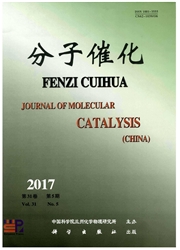

 中文摘要:
中文摘要:
用沉积-沉淀法制备了一系列不同Sn/Ti比例的纳米催化剂SnO2/TiO2,以糖蜜酒精废水的脱色降解为探针反应,研究了在紫外光条件下Sn/Ti比和焙烧温度对其臭氧化活性的影响.结果表明,在Sn掺杂量为5%(m01)时,焙烧温度773K时,SnO2/TiO2催化活性最好.XRD、TPR显示,部分Sn^4+可能掺入到TiO2的晶格之中,形成了Sn-O-Ti键.紫外漫反射光谱显示,复合SnO2/TiO2对光的吸收明显增加,催化活性的提高应归因于SnO2/TiO2表面的臭氧吸附.SnO2/TiO2光催化臭氧化降解糖蜜酒精废水的活性与臭氧在催化剂表面的吸附分解有很大的关系,光的作用只是强化催化臭氧化的氧化效果.
 英文摘要:
英文摘要:
A series of different Sn/Ti proportion of the nanometer photo-ozone catalyst SnO2/TiO2 was prepared by deposition-precipitation method. The surface and structure of SnO2/TiO2 were characterized by X-ray diffraction ( XRD), Ultraviolet visible and temperature programmed reduction (TPR). The decolorization of molasses fermen- tation wastewater was used as a probe reaction to study the effect of different Sn/Ti proportion and the calcinations temperature. The results indicate that optimum percentage of SnO2 is 5% (tool) compared with TiO2 and the optimal calcination temperature is 773 K. XRD and TPR showed that some Sn^4+ was likely to enter into the TiO2 lattice, and Sn-O-Ti bond was formed. Ultraviolet visible diffuse reflectance spectra showed that the absorption of light was obviously increased, and the catalytic activity of SnOR/TiO2 increasing should be attributed to the improvement of the ozone adsorption on SnO2/TiO2 surface. There may be close relationship between the catalytic activity of SnO2/TiO2 photo-ozone catalytic degradation of molasses fermentation wastewater and the adsorptiondecomposition of ozone on catalyst surface, and the light only strengthen the catalytic oxidation effects of ozone. Using a 5% Sn proportion SnO2/TiO2, which calcined at 773 K for 2h, as catalyst, under a reaction condition of 300W ultraviolet light and ozone, the decolorization of molasses fermentation wastewater diluted to 20 times was 91.29% after 60min.
 同期刊论文项目
同期刊论文项目
 同项目期刊论文
同项目期刊论文
 期刊信息
期刊信息
